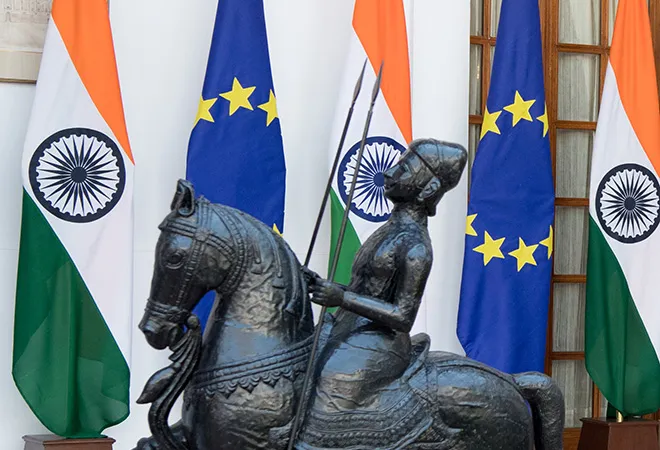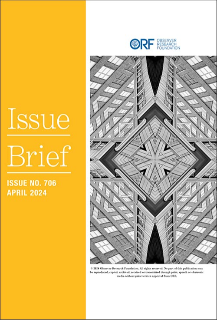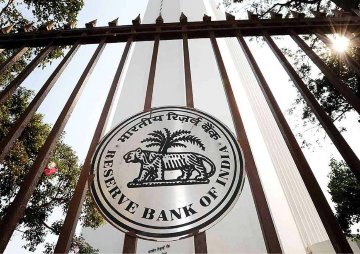
The beginning of the rollout of Beijing’s Belt and Road Initiative (BRI) between 2013–2015 has already redefined the vocabulary of international relations, especially that of engagement between major economic powers and developing nations. The concept of ‘connectivity’ has since then risen to the top of the foreign policy agenda of virtually all global players, including the European Union (EU) and India. Determined, at least on paper, to offer a competitive, more sustainable alternative to the BRI, Brussels and New Delhi have committed to increase cooperation on connectivity initiatives by signing the “EU-India Connectivity Partnership” on 8 May 2021.
Features of the partnership
The Partnership builds upon previous bilateral agreements, such as the recent “EU-India Strategic Partnership: A Roadmap for 2025” (July 2020), and ties into the larger European pivot towards Asia, conceptualised in the EU Indo-Pacific strategy released in April 2021. EU-India cooperation on connectivity is predicated on shared values of “democracy, freedom, rule of law, and respect for human rights” and operational principles of transparency, viability, inclusivity, and sustainability. The stated objective is that of strengthening and expanding the existing network of economic, social, and political bonds that tie the two regions together, as well as bringing in third-party countries, through a combination of soft and hard connectivity initiatives. The areas of cooperation identified within the framework of the partnership are digital, transport, energy, and people-to-people connectivity. Financing is expected to partially originate from European and Indian public agencies, but significant emphasis is put on the essential role that the private sector is poised to play, so as to ensure diversity in investment streams and achieve mutually beneficial gains.
EU-India cooperation on connectivity is predicated on shared values of “democracy, freedom, rule of law, and respect for human rights” and operational principles of transparency, viability, inclusivity, and sustainability.
The EU-India Connectivity Partnership bears the promise of fundamentally changing the dynamics of development within the Indian Ocean basin, by establishing a greener, fairer, and more transparent framework of infrastructural investment. In the same breath, it would pull India and the EU closer together, tapping into the potential of what could prove to be a defining, alternative third pole to the US-China binary. However, there appear to be as many obstacles as there are incentives to the realisation of the ambition set out by the Partnership. Can the EU overcome internal and external hurdles and prove to be a reliable, long-term connectivity partner for India?
The first factor that will inform the success of the EU-India Connectivity Partnership is the actual capacities that the EU currently possesses to implement the various elements of the initiative. The European Commission, to reduce the Union’s chronic institutional redundance, has moved to combine all current financing instruments for external action into one budgetary mechanism known as the “Neighbourhood, Development and International Cooperation Instrument” (NDICI), to which it has allocated 79.5 billion euros between 2021 and 2027. Within that sum, 8.49 billion euros will specifically be available for international development initiatives in Asia and the Indo-Pacific. The NDICI represents a significant step forward for the European connectivity agenda, not only because of its 12 percent size increase with respect to the previous period, but also because it is expected to significantly simplify the governance and implementation of EU-led initiatives. Furthermore, the NDICI comprises financial guarantees to third-party investors—whether institutional, such as the European Investment Bank (EIB), or private. Indeed, the 53.45 billion euros of the “External Action Guarantee” are meant to act as a cushion against sudden financial shocks in countries that have historically been prone to it, so as to attract the expected 500 billion euros of private investment that the European Commission needs to complement public financing.
The first factor that will inform the success of the EU-India Connectivity Partnership is the actual capacities that the EU currently possesses to implement the various elements of the initiative.
The NDICI is undoubtedly a powerful instrument in the EU toolkit, which can be effectively utilised in coordination with India to promote connectivity in the Indo-Pacific. However, European investment is not only defined by its financial magnitude, but also by the framework of norms and principles that govern it. Indeed, the European Commission has conceptually and rhetorically located EU connectivity initiatives within the larger narrative of ‘the European Way’ of engaging internationally. This ties back into the EU identity as a normative power, which is that one exercises its influence not by coercion, but rather through the shaping of the framework of norms that govern international affairs. Connectivity initiatives are, firstly, to be designed and executed in line with the guiding principles indicated by the European Council: Sustainability, meaning environmental, social, economic, and fiscal; comprehensiveness; transparency; and fairness. Secondly, connectivity projects are themselves a medium to promote those very norms at the international level. Indeed, the Council has made explicit reference to how the EU connectivity agenda can be used to bolster European initiatives globally, such as the “European Green Deal” and the “2030 Digital Compass”.
While the EU has significantly scaled up its connectivity efforts and integrated them in its long-term foreign policy agenda, questions remain as to its ability to overcome the hurdles that stand on its way to fully realising the objectives of the EU-India Connectivity Partnership. The European Union has so far struggled translating its economic might into a corresponding level of geopolitical influence. The reasons attributed to this gap are multiple, both rooted in internal dysfunction and external limitations. These chronic problems, thus, threaten to undermine the EU connectivity agenda in the Indo-Pacific and its emerging partnership with India.
Divergence from within EU
In terms of domestic challenges, the European Union still has to do more to ensure cohesiveness in its Indo-Pacific strategy. As noted by Gavas and Pleeck, while the NDICI represents a step in the right direction, it does in no way completely solve the bureaucratic overgrowth that has stifled EU global action so far. They specifically point to the “annuality” principle of the EU budget as a likely source of distortion in the use of connectivity funds. That is because the yearly rate of disbursement might end up being prioritised over the quality and the long-term continuity of actions and investments. Chauvin goes as far as questioning the EU’s will to commit to a more proactive international stance, dubbing the NDICI as “Status Quo+”. He argues that the enduring over-reliance on “blending” as a form of financing is going to lead to the EU losing control of their connectivity initiatives to their partners on the ground, as well as of the political visibility that comes with it. Finally, internal divergences amongst the individual approaches of EU member states are bound to create friction and to further slow down decision-making and implementation. Indeed, with countries such as Hungary, which has warmed up to China in the last few years, and Germany, which has been very reluctant to alienate Beijing, a bolder Indo-Pacific policy is hard to imagine.
European officials need to ramp up efforts to coordinate with all the relevant partners in the region. That means, of course, India, but also the United States, Japan, Australia, and ASEAN.
When it comes to external inhibiting factors, Brussels has to step up its diplomatic game if it really aspires, in conjunction with Delhi, to provide a competitive alternative to the BRI. China has intensely been promoting its global connectivity initiative in the international fora—such as within its own Belt and Road Summit, which in 2020 was attended by representatives from 80 different countries. Furthermore, connectivity in the Indo-Pacific is not a level playing field. Chinese projects move faster—due to a general lack of due process in the bidding phase, they are backed by readily available loans, and they do not entail the kind of conditionalities that their European and Indian equivalents would. Indeed, the principles enshrined in the EU-India Connectivity Partnership—sustainability, comprehensiveness transparency, and fairness—could be perceived as additional costs or impossibly high standards by developing countries. Lastly, European officials need to ramp up efforts to coordinate with all the relevant partners in the region. That means, of course, India, but also the United States, Japan, Australia, and ASEAN. A web of ad hoc bilateral agreements between some of these powers already exists. However, if not corrected, this geopolitically fabricated redundancy of international investment will (1) lead to unnecessary competition between otherwise aligned countries, and (2) originate projects that respond to macro-level strategic considerations rather than on the ground connectivity needs.
|
‘Neighbourhood’ |
Sub-Saharan Africa |
Asia-Pacific |
| EU funds 2021-2027 |
€19.32 billion |
€29.18 billion |
€8.49 billion |
| Main EU programmes and partnerships |
European Neighbourhood Policy, Western Balkans Economic Investment Plan, Eastern Partnership |
Africa-Europe Alliance for Sustainable Investment and Jobs (Task Force on Transport and Connectivity) |
Connecting Europe and Asia, EU-India, EU-Japan Connectivity Partnerships |
Conclusion
The EU-India Connectivity Partnership and the recent restructuring of EU external action funding are both significant developments towards the establishment of an alternative connectivity partner for developing countries in the Indo-Pacific. The EU seems to have correctly understood that joining efforts with India is the way to ensure its influence is felt in the region, and it has consequently allocated more resources to implementing connectivity initiatives in its 2021-2027 budget. However, if Brussels is serious about building a meaningful cooperation with Delhi, it is imperative that it addresses its own internal incongruencies, and that it formulates an inclusive, coherent, and context-specific diplomatic vision.
The views expressed above belong to the author(s). ORF research and analyses now available on Telegram! Click here to access our curated content — blogs, longforms and interviews.




 PREV
PREV

